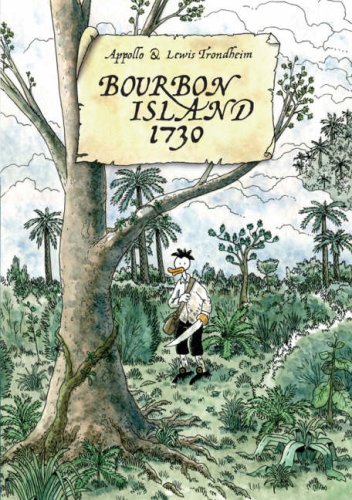'On Bourbon Island off the coast of Madagascar, a French ornithologist and his assistant are caught up in an adventure involving slavery, colonialism, and the last days of the great pirates'. So goes the summary of the 288-page black and white graphic novel Bourbon Island 1730, by Lewis Trondheim and Appollo, translated into English by Alexis Siegel.
 |
| front cover, Bourbon Island 1730 |
Although I could have read the original in French (despite their names, both authors are French) I was eager to read a rare English translation of a book about Reunion Island ('Bourbon' is the former name of Reunion).
 |
| back cover |
In a colonial community that is just beginning to find itself, the ornithologist Despentes and his assistant Raphael Pommery are supposed to be in search of the almost-extinct local version of the dodo - the solitaire - but Pommery is soon entranced with the pirate inhabitants of the island, becoming obsessed with the romance of a vision of the world where all people are free and equal regardless of their skin colour. Against a backdrop of slavery former freebooters debate whether to try and release from jail the infamous pirate 'Buzzard' (Olivier Levasseur aka La Buse) by a show of force. In the end however the ornithologists are witness to the extinction of both bird and pirate.
 |
| Gravestone of the pirate La Buse in St Paul, Reunion (source) |
This historical drama is published by First Second and is printed on good quality heavy paper stock (with a torn effect edging - similar to a pirate's treasure map?), featuring anthropomorphised animal characters, drawn in black and white by Lewis Trondheim (real name Laurent Chabosy). Trondheim and Appollo (a pseudonym for Olivier Appollodorus, who knows Reunion well) both wrote the fictional story, which is freely inspired by past events, and is not intended to be a historical account. The detailed endnotes however indicate the reliance on historical facts and documents for some of the background for the story.
 |
| "And there young man, what do you see?" An example of the book's animal characters. |
Although the characters are portrayed as animals this does not make them 'cute'. Trondheim’s pen-and-ink style of drawing took me a little getting used to, and the characters don't always 'stick out' visually. More of an intellectual than physical adventure, the story explores the world of pirates and early colonialism, and the exploitation of slaves. The translation is generally excellent, apart from a few translations of local terms that I found rather jarring (an occupational hazard for me perhaps?). At the end are detailed notes which help to connect you to this period of history. Although I've spent almost 20 years on Reunion and consider myself fairly knowledgeable about the island's history there were several points I was interested to learn about it. The ending is rather abrupt, but overall this was a very enjoyable read.
| Olivier Levasseur's cryptogram, thrown to the crowd from the scaffold before he was hung (Wikipedia) |
I would recommend it to any adult or young adult who has an interest in 18th century history, pirates, colonialism, slavery or Reunion and the Indian Ocean.
Book details:
Bourbon Island 1730 by Lewis Trondheim and Olivier Appollodorus, 288 pages, published by First Second, October 2008, ISBN-13: 978-1596432581.
Translations of the book into other languages also exist:
Further reading:
Appollo also wrote a graphic novel in two volumes set at Maison Rouge, an old colonial estate which I blogged about here.
If you enjoyed this post you might also like:
- Dutch - Het eiland Bourbon 1730 / druk 1, translated by Gert Jan Pos
- German - Die Insel Bourbon 1730, translated by Kai Wilksen
- Polish - Wyspa Burbonów rok 1730, translated by Maria Mosiewicz-Szrejter
- Croatian - Otok Bourbon 1730, translated by Milena Benini
- Spanish - La isla de Borbón 1730, translated by Sergio España, Ana Millán, and Paco Rodríguez.
Further reading:
- Olivier Appollodorus page on Wikipedia (in French)
- Libertalia - a (possibly fictional) anarchist colony founded in the late 17th century in Madagascar by pirates.
- Pierre Benoît Dumas - Governor of Bourbon (Reunion) 1727-1735.
- John Taylor - together with Olivier Levasseur he captured the most valuable prize in pirate history off the coast of Reunion in 1721.
























